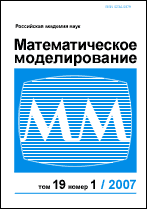|
This article is cited in 8 scientific papers (total in 8 papers)
Mathematical models and computer experiment
High impact modeling with smooth particle hydrodynamics
Yu. V. Blazhevich, V. D. Ivanov, I. B. Petrov, I. V. Petviashvili
Moscow Institute of Physics and Technology
Abstract:
High-speed impact of solid body is considered. This arises in a study of asteroid danger, antimeteoric protection of space ship hull, penetration problem, etc. As it is known, during numerical modeling of the processes like these the next problems appears construction and choice an adequate mathematical models (especially when it is necessary to solve problem in wide pressure, temperature and deformation range), adequate numerical solution description in range of large gradients and large deformation. These problems are considered in details in [1–15]. For rise of numerical solution quality with discontinuity singularity, methods, which use key properties of hyperbolic equations system [3, 4, 8, 11, 12], hybrid methods [16–18] and different regularization methods [19, 20], were mainly applied. Problems of obtaining dynamically deformed solid body equations one can find in [4, 9, 12], wide range equation of state presented in [21, 22].
In numerical studies of solid body intensive loading, Lagrangian grids with restructurization,
Euler grids with marker method and dynamic grids were used. However, for the most complex cases (destruction, phase conversion, substance departure), particle method [7] or smooth particle method (“Smoothed Particle Hydrodynamics” – SPH) [15] are the best, because any other methods are too complex (technically or theoretically). In the present paper numerical solution of high-speed impact of solid body (asteroid collision with the Earth, impact with multilayer armor) by SPH-method are considered. Calculation results are presented.
Received: 30.04.1998
Citation:
Yu. V. Blazhevich, V. D. Ivanov, I. B. Petrov, I. V. Petviashvili, “High impact modeling with smooth particle hydrodynamics”, Matem. Mod., 11:1 (1999), 88–100
Linking options:
https://www.mathnet.ru/eng/mm1055 https://www.mathnet.ru/eng/mm/v11/i1/p88
|

|




 Contact us:
Contact us: Terms of Use
Terms of Use
 Registration to the website
Registration to the website Logotypes
Logotypes








 Citation in format
Citation in format 
